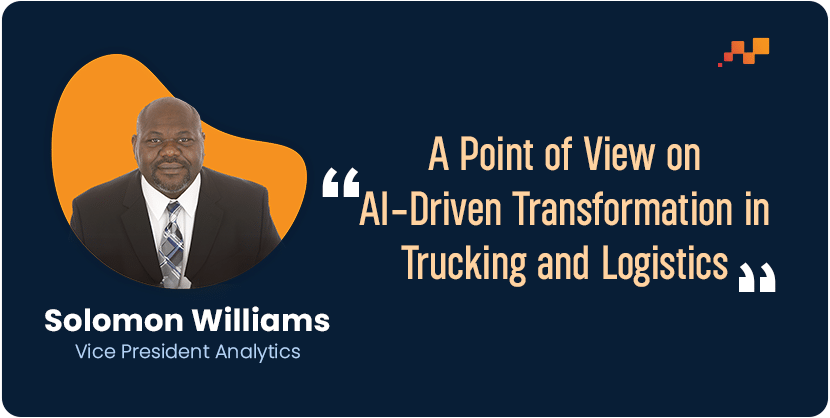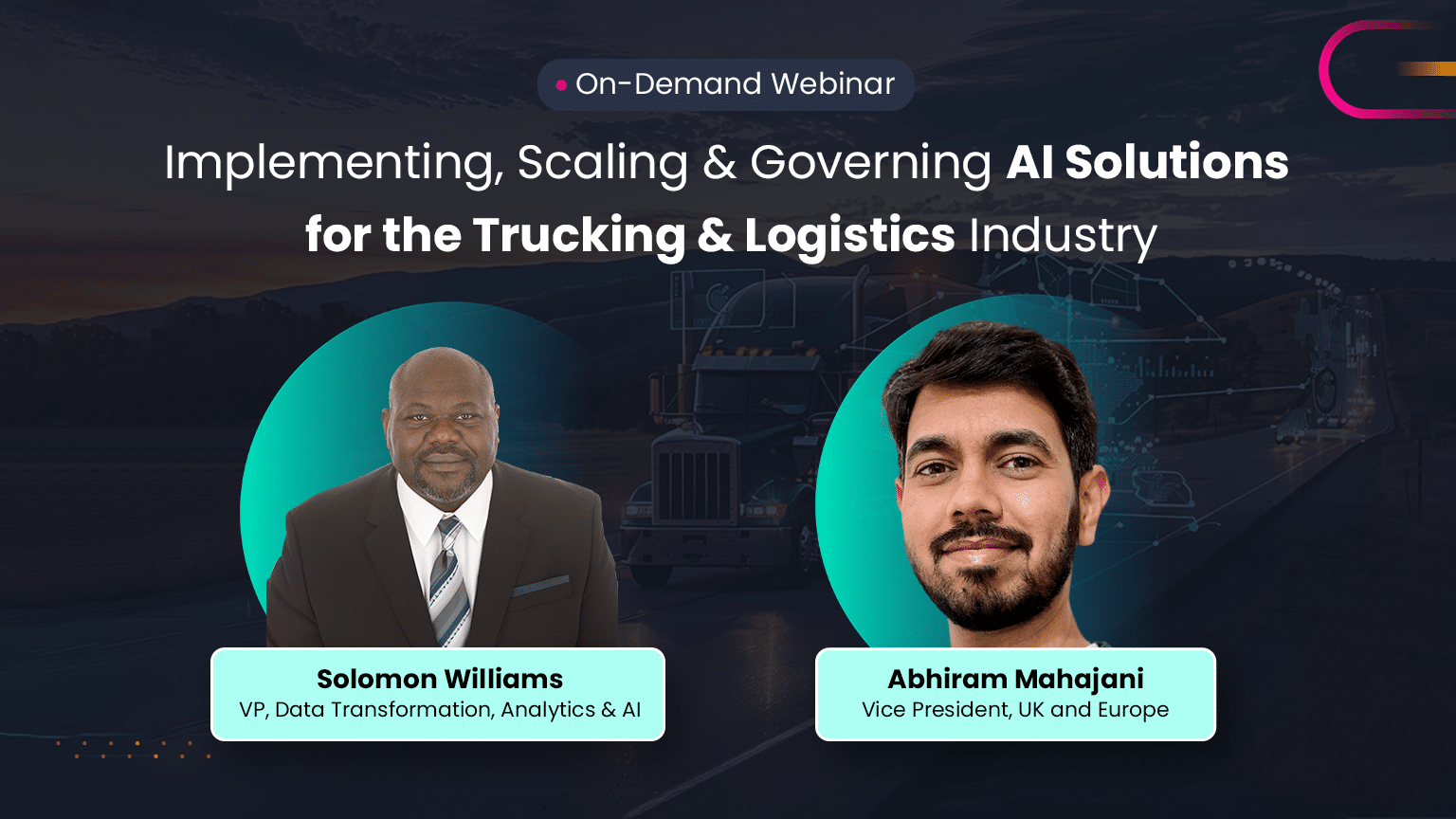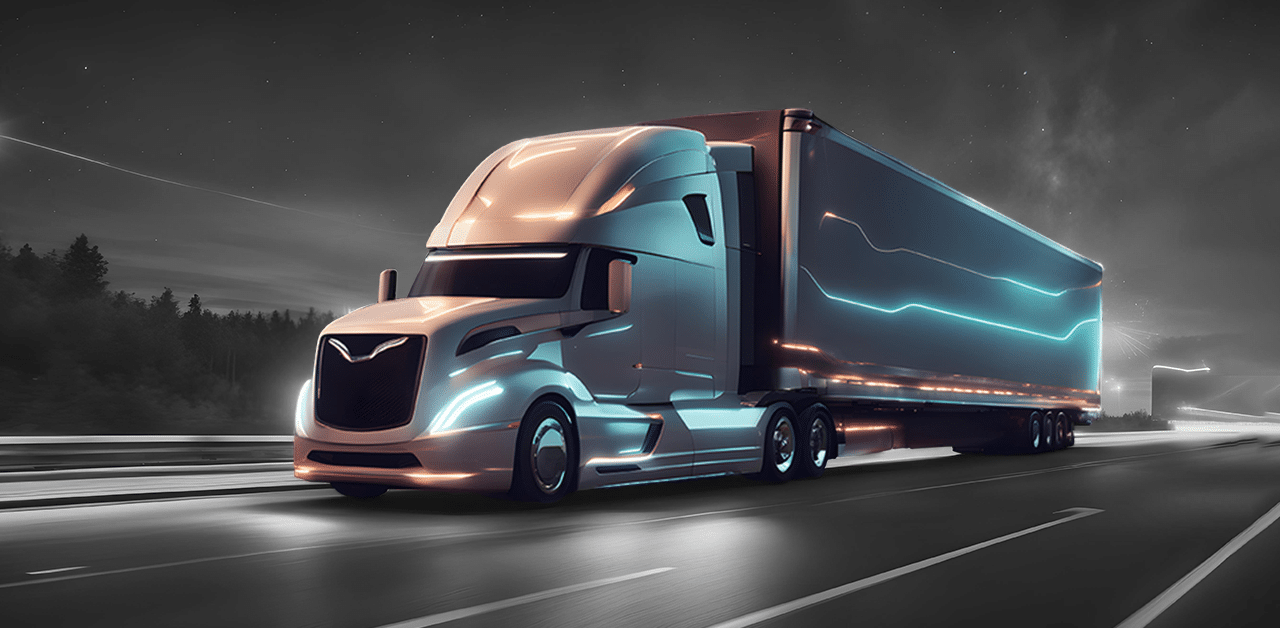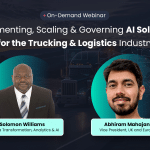Why this blog?
Managing the complexities of the trucking and logistics industry can be daunting, especially with unprecedented challenges and evolving trends. In this article, Solomon, an AI solutions expert in the trucking and logistics industry explains how to leverage data, analytics, and AI to enhance efficiency and compliance. Gain actionable insights to stay competitive and informed in a rapidly changing landscape.

What is the current scenario of the Trucking and Logistics industry? What emerging trends are currently redefining the industry?
The trucking industry is still in the midst of the longest and deepest recession in history. As of 2024, some industry indicators point to relief on the horizon, but many challenges remain ahead.
Key factors shaping the industry include:
- Heightened competition and customer demand driving down rates
- eCommerce explosion pressuring market segments
- Persistent driver shortages
- Difficulty in reliably forecasting demand management
- Rate suppression and depression in many markets
- Higher costs of tractors and trailers due to new regulations
- Fraud from scammers imitating carriers, brokers, and insurers
- High consolidations with carriers, brokers, and 3PLs/4PLs overcoming legacy acquisition cost
- Red Sea supply chain issues affecting global stability
What strategies can legacy logistics companies adopt to fend off competition from tech startups and mega-retailers?
Trucking and logistics companies have traditionally not been early adopters of technology, which has always been a challenge. However, adopting advanced analytics and AI-driven solutions is no longer about maintaining a competitive edge; it is a matter of survival. Large national and global carriers have the advantage of size to negotiate better contracts and form partnerships to expand their coverage.
In contrast, regional, mid-size, and smaller carriers must invest in data, analytics, and AI solutions to gain useful insights that enable more efficient operations, such as route planning and optimization, better equipment utilization, and real-time profitability analysis. This allows them to manage tenders more effectively by making informed decisions on what to accept and reject.
How can trucking companies optimize their data quality and availability to enhance decision-making and reduce operational costs with AI-driven solutions?
New trucks are being equipped with advanced safety features and data reporting systems. Many trucking and logistics companies now require dashcams in their vehicles, and automation, such as self-driving trucks and automated loading and unloading systems, to help reduce costs and increase efficiency. All this data must be collected and managed effectively, not only for the safety and protection of operators and organizations but also for financial and risk management benefits.
Utilizing this data effectively is about more than just quality and availability; it’s about usability. To unlock the value contained in this data, trucking and logistics organizations must implement a robust, integrated data governance, data management, analytics, and AI strategy. Several years ago, this was a good-to-have. A few years ago, it was a competitive advantage. Today, it’s a matter of survival.
For trucking companies, what strategies are effective in navigating technical challenges during both AI implementation and scaling phases?
Several factors affect AI implementation and scaling for the Trucking and Logistics industry that include:
- Many trucking and logistics companies are led by industry veterans who possess a deep understanding of the business but may lack familiarity with emerging technologies
- Consequently, technical resources are often sourced from outside the industry or recruited straight out of college. While these new hires offer fresh perspectives, they may not have an in-depth knowledge of the industry’s intricacies
- Trucking and logistics leaders are often swayed by the promises of software and technology vendors, who claim their platforms can do it all and offer rapid returns on investment
- However, legacy T&L organizations still grapple with mainframe-based systems and a significant amount of legacy data that is paper-based, unstructured, and of poor quality
Implementing AI solutions requires a comprehensive strategy, not just a use case. You need to consider what the solution will solve or provide insight into, and then work upstream from there. Do you have the necessary data? Is the data quality acceptable? How is this data governed? Are privacy and ethics concerns adequately protected? How will you manage these requirements and the lifecycle needs of AI solutions?
In short, a strategy is essential. It’s not just about the platform, coding language, or end-state. To implement, scale, and govern AI-enabled solutions effectively, you must have a robust Data and AI Governance program aligned with your integrated data, analytics, and AI strategy.
What role does data governance play in the successful implementation and scaling of AI solutions in the industry?
Data governance is the process of ensuring that data is secure, accurate, available, and usable throughout its lifecycle. It involves establishing internal standards or data policies that govern how data is gathered, stored, processed, and disposed of, as well as complying with external standards set by industry associations, government agencies, and other stakeholders. Data governance is fundamental to implementing and scaling AI solutions.
However, it doesn’t end there. AI governance is also crucial. AI governance is the system by which an organization manages the development and use of AI systems. It includes a wide range of structures, policies, skills, practices, and mechanisms that guide AI use, monitoring, and management, encompassing the entire development and management lifecycle of AI solutions.
How can AI automation alleviate burdens and improve compliance regulatory needs?
There is literally a litany of benefits to T&L operators who choose to leverage AI automation.
Here are a few initiatives Factspan has implemented:
- Real-time Monitoring and Reporting: AI-driven automation solutions can continuously monitor and gather data on vehicles, drivers, and cargo in real-time to ensure compliance with regulations such as hours-of-service (HOS) rules, vehicle weight limits, and hazardous materials regulations.
- Route Optimization: AI-driven automation solutions can dynamically optimize trucking routes to minimize fuel consumption, reduce emissions, and comply with regulations related to restricted roads, bridges, or areas with environmental restrictions. By considering factors such as traffic conditions, road closures, and regulatory requirements
- Driver Behavior Monitoring: AI-driven automation solutions can analyze driver behavior data from onboard sensors, cameras, and other sources to detect violations of safety regulations, such as speeding, aggressive driving, or distracted driving.
- Electronic Logging Devices (ELDs): ELDs are mandated for tracking drivers’ hours-of-service (HOS) compliance. AI-driven automation solutions can enhance the functionality of ELDs by providing predictive analytics to optimize scheduling, rest breaks, and route planning, ensuring that drivers remain compliant with HOS regulations while maximizing productivity and minimizing downtime.
- Automated Documentation and Reporting: AI-driven automation solutions can streamline the process of generating and managing regulatory documentation, such as driver logs, inspection reports, and shipment records. By automatically capturing and processing data from various sources, AI can reduce the administrative burden on drivers and fleet managers while ensuring accuracy and compliance with regulatory requirements.
- Risk Management and Compliance Audits: AI-driven automation solutions can analyze vast amounts of data to identify patterns and trends related to compliance risks, such as recurrent safety violations or non-compliant behaviors. By flagging potential issues and prioritizing corrective actions, AI can help trucking companies improve compliance with regulatory requirements and reduce the risk of penalties or fines during audits.
For example, by automating the generation of reports and initial drafts, organizations can save substantial amounts of time and reduce personnel costs. Additionally, enhanced data analysis capabilities allow businesses to optimize their operations by identifying inefficiencies and areas for improvement, leading to further cost savings and productivity gains. We have been working on building the Insights co-pilot and have received good response from our stakeholders, it helps in generating the automated insights and visual data using NLQ.
Can strategic partnerships with data companies help trucking companies navigate regulatory changes and infrastructure modernization?
Partnering with firms like Factspan, specializing in data, analytics, and AI solutions, is a strategic decision for the future. Meeting industry and governmental regulatory requirements hinges on the intersection of data and process. While technology is important, there is no silver bullet or platform collection that substitutes for an integrated data, analytics, and AI strategy aligned with an organization’s business capabilities and objectives. Such partnerships minimize the risk of falling into a technology “money-pit,” acquiring technologies that don’t meet long-term goals, or ending up with minimally viable solutions that are difficult to manage, expensive, time-consuming, and complex to scale.

FAQ’s
What are the current challenges faced by the trucking and logistics industry?
The industry is dealing with heightened competition and customer demand driving down rates, an explosion in eCommerce pressuring market segments, persistent driver shortages, difficulty in reliably forecasting demand, rate suppression in many markets, higher costs of tractors and trailers due to new regulations, and Red Sea supply chain issues affecting global stability.
What AI innovations are changing the trucking industry?
- Advanced Route Optimization & Smart Transportation
- Predictive Maintenance
- Autonomous Driving
- Driver Behavior Monitoring
- Intelligent Load Matching
How can trucking companies effectively manage the higher costs of tractors and trailers due to new regulations?
To manage higher costs, trucking companies can explore leasing options, invest in fuel-efficient and environmentally friendly vehicles that reduce long-term operational expenses, and take advantage of government incentives for compliant vehicles. Additionally, implementing maintenance programs to extend the lifespan of existing equipment can help mitigate the impact of these costs.
Why is data quality and availability important for trucking companies?
High-quality and readily available data enable trucking companies to make informed decisions, reduce operational costs, and enhance efficiency. Advanced data reporting systems and automation in new trucks can provide valuable insights for better route planning, safety measures, and financial management, which are essential for surviving in the competitive market.
What strategies are effective for trucking companies in implementing and scaling AI solutions?
Effective strategies include having a comprehensive AI implementation plan, ensuring data quality and governance, and addressing privacy and ethical concerns. Companies should also integrate their data, analytics, and AI strategies and ensure they have the necessary infrastructure and skilled personnel to manage AI technologies effectively, having the right partner gets the job done without hassle.










